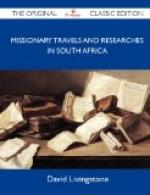The people living along the path we are now following were quite accustomed to the visits of native traders, and did not feel in any way bound to make presents of food except for the purpose of cheating: thus, a man gave me a fowl and some meal, and, after a short time, returned. I offered him a handsome present of beads; but these he declined, and demanded a cloth instead, which was far more than the value of his gift. They did the same with my men, until we had to refuse presents altogether. Others made high demands because I slept in a “house of cloth”, and must be rich. They seemed to think that they had a perfect right to payment for simply passing through the country.
Beyond the Chikapa we crossed the Kamaue, a small deep stream proceeding from the S.S.W., and flowing into the Chikapa.
On the 30th of April we reached the Loajima, where we had to form a bridge to effect our passage. This was not so difficult an operation as some might imagine; for a tree was growing in a horizontal position across part of the stream, and, there being no want of the tough climbing plants which admit of being knitted like ropes, Senhor P. soon constructed a bridge. The Loajima was here about twenty-five yards wide, but very much deeper than where I had crossed before on the shoulders of Mashauana. The last rain of this season had fallen on the 28th, and had suddenly been followed by a great decrease of the temperature. The people in these parts seemed more slender in form, and their color a lighter olive, than any we had hitherto met. The mode of dressing the great masses of woolly hair which lay upon their shoulders, together with their general features, again reminded me of the ancient Egyptians. Several were seen with the upward inclination of the outer angles of the eye, but this was not general. A few of the ladies adopt a curious custom of attaching the hair to a hoop which encircles the head, giving it somewhat the appearance of the glory round the head of the Virgin (wood-cut No. 1*). Some have a small hoop behind that represented in the wood-cut. Others wear an ornament of woven hair and hide adorned with beads. The hair of the tails of buffaloes, which are to be found farther east, is sometimes added. This is represented in No. 2. While others, as in No. 3, weave their own hair on pieces of hide into the form of buffalo horns; or, as in No. 4, make a single horn in front. The features given are frequently met with, but they are by no means universal. Many tattoo their bodies by inserting some black substance beneath the skin, which leaves an elevated cicatrix about half an inch long: these are made in the form of stars, and other figures of no particular beauty.
* Unfortunately these wood-cuts
can not be represented in this
ASCII text.
No. 1 appears like a wheel with
spokes of hair
connecting it to the head.
No. 2 appears somewhat like a tiara
sloped forward, as the bow
of a ship.




